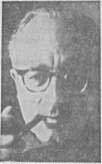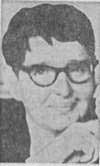A review by Carroll Quigley in
The
Washington Sunday Star, 25 January 1970,
of a book:
HAMLET'S MILL:
An Essay on Myth and the Frame of Time,
by Giorgio de Santillana and Hertha von
Dechend.
Boston: Gambit, Inc., 19xx
"Delving Into
'Linguistic Archaeology"
By CARROLL
QUIGLEY
HAMLET'S MILL: An Essay on Myth and the
Frame of Time.
By Giorgio de Santillana and Hertha von
Dechend. Gambit, Inc., Bostqn. 505 pages. $10.
Just 40 years ago, my undergraduate tutor told me of a new member
of the faculty at MIT, a young historian of science, recently arrived
from Rome, who had "read everything." Now, a generation later,
Giorgio de Santillana still seems to have read everything. But,
recently, his reading has taken strange paths, delving into the endless
labyrinths of folklore, astrology, and what might be called "linguistic
archaeology."
This last subject is concerned with the evidence to be found in
etymology and forgotten metaphors of men's thoughts and human society in
the prehistoric period. Thus, for example, the expression "the
four corners of the earth" takes us back, in this book, to a period at
least 7,000 years ago (that is, 3,000 years before the invention of
writing), when the "world" was not a terrestrial globe but was regarded
as a flat square plane (what astronomers call "the plane of the
ecliptic"), whose four corners cut the zodiac band of "fixed" stars in
four points of the 12 constellations which make up the whole circular
band of the zodiac.
Those ancient peoples, looking at the sky with themselves at the
center, saw the sun pass through the whole band in the course of the
year, reaching the "four corners" at the points we call the two
equinoxes (March 21 and Sept. 22) and the two solstices (June 21 and
Dec. 21). According to this book, our very remote ancestors not
only knew these things, but they also knew that these four corners are
not fixed forever in the same points relative to the constellations of
the zodiac but move slowly backward, only 1 degree each 72 years, toward
the circling sun, so that the vernal equinox on March 21 (which was New
Year's Day until Caesar reformed the calendar in 45 B.C.) is now in
Pisces, after being in Aries for about 2200 years before 7 B.C. and was
in Taurus from about 4400 B.C. to about 2200 B.C. Thus at "Time Zero,"
when men first recognized these things, about 5000 B.C., the vernal
equinox was in Gemini.
The Christian era, since Christ was born, about Aug. 7 B.C., thus
coincides exactly with the reign of the Fish and not with the Ram,
because the Old New Year's Day sun moved from Aries into Pisces in that
very year. And Virgil is regarded as a prophet of Christ, serving, for
example, as Dante's guide through Hell and Purgatory in "The Divine
Comedy," because he, seeing the approach of Pisces, wrote, before the
birth of Christ, "A great new order of centuries in now being born."

Giorgio de
Santillana
The discovery
of the Precession of the Equinoxes is usually attributed to the Greek,
Hipparchus, about 127 B.C. The argument in this book that men knew of it
5000 years earlier will astound most readers. This is equally true
of some of its other ideas: (1) That the chief evidence of this
knowledge survives in folk tales; (2) that this knowledge was
practically world-wide, and can be seen in the folklore and symbols of
the ancient Aztecs, tribal American lndians, Polynesians, African
Negroes, or Siberian Shamnaism as clearly as in the surviving written
evidence from Ancient Egypt, Babylonia, Archaic Greece, or traditional
Hinduism; and (3) that we today have been unable to see the meaning of
this evidence from our mistaken 19th century belief that man's spiritual
and intellectual development moves in only one direction, forward, and
is unlikely to retrograde on a general or worldwide basis.
There can be little doubt that these ideas are correct, including
the last one. The great astronomical knowledge of 5000 or 4000
B.C. was largely lost by 1000 B.C. and has had to be rediscovered.
But we refuse to see that the astronomical knowledge shown by such
things as the orientation of the Great Pyramid (aboot 2350 B.C.) or of
Stonehenge (about 1650 B.C.) are from the late stages of a decreasing
body of pre-literate astronomical knowledge, and we persist in regarding
them as precocious examples of a growing body of our own literate
scientific tradition. The efforts of these authors to show us an aspect
of this older, and very great, prehistoric esoteric tradition are very
much worthwhile.

Hertha von
Dechend
Unfortunately, this volume is unlikely
to persuade doubters, chiefly because it is badly organized and badly
written. The main arguments should have been stated clearly at the
outset, and the evidence, including that derived from folklore, should
then have been mobilized to support the arguments. Instead, the
arguments emerge only by implication, and not in the early chapters,
where they are buried and confused by a flood of stories from worldwide
folklore fragments.
The scholarship of the authors is beyond question: it is shown in
33 appendices covering a hundred pages and in a bibliography in five
languages covering 30 pages. But the purpose of the book is
largely defeated, not by its scholarship but by its confused
presentation. Who could guess what the book is about from its
title or subtitle? The chapter headings and the language of the text are
similarly allusive and poetical. But a scientific argument has to
be written in the clearest prose possible, with the thesis presented and
precision. No theses such as these can emerge by implication nor be
proved by even the most copious cumulation of ambiguous stories from
folklore. It might be suggested to any puzzled reader of this volume
that he will find a lucid explanation of what it is all about in the
first chapter of a wonderful, if somewhat older, book: Lancelot Hogben's
"Science for the Citizen" (Knopf, 1938).
There Is a second weakness in this volume: Its authors are so
obsessed with the precession of the equinoxes that they refuse to see
that primitive thinkers had other worries. They go so far as to
write (p. 56), "Archaic thought is cosmological thought first and last,"
and, in several places, they reject the widely accepted idea that much
of archaic thought and symbolism is concerned with fertility.
In this they are in grave error and simply reveal their inability
to get inside the minds of archaic men. Such men were worried by
all the cyclical periodicies of nature: the day, the month (including
their wife's menstrual cycle), the seasons (especially the retreat of
the sun in December), the year, the succession of generations, and the
precession of the equinoxes. The last was only the longest of these
cycles; it was not the greatest worry. But all these cycles must be
studied and understood if we are to comprehend the fears and
insecurities of archaic men, who, lacking all conception of rules and
laws of inanimate nature, saw all its periodicies as the consequence of
the activities of gods and spirits on whom men were almost helplessly
dependent.
Carroll Quigley is professor of the
history of civilization at Georgetown University and author of "Tragedy
and Hope: The World [in] Our Time." (Macmillan,)